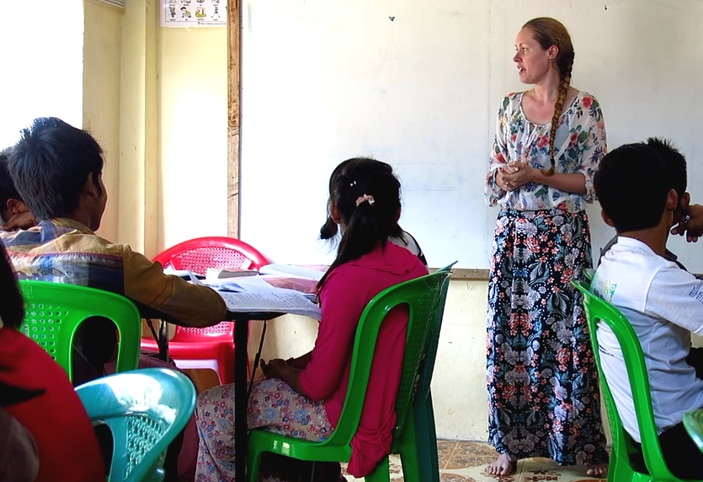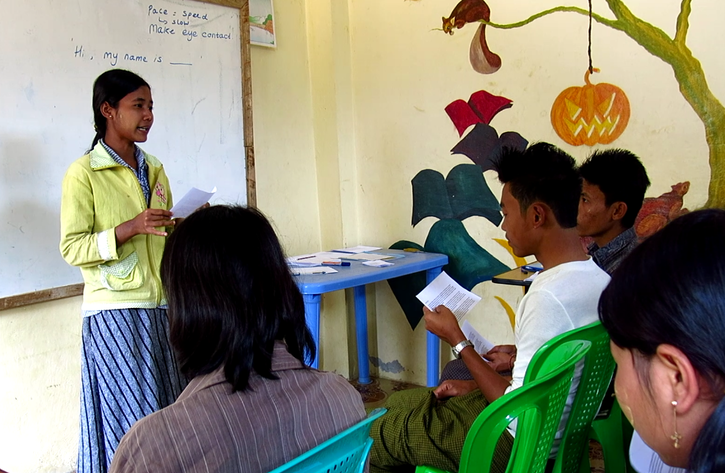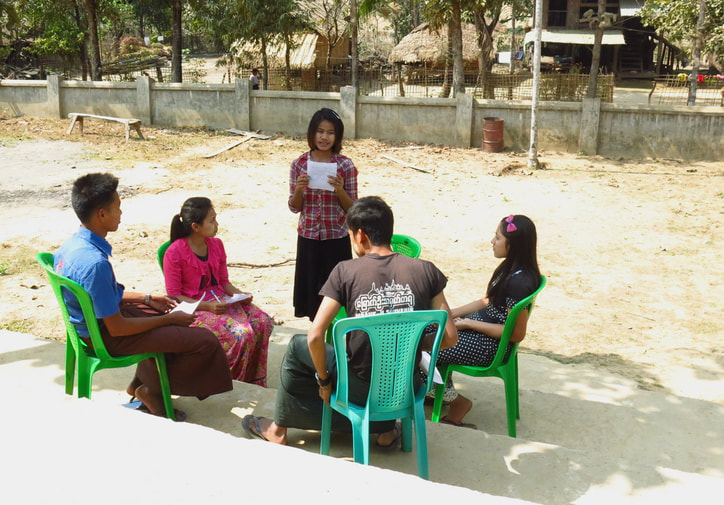|
On Tuesday our volunteer teachers did the second set of presentations that I have seen them do. The first involved standing on chairs. Never a good tip for a presentation. Especially when the presentation continues with fits of nervous giggling and a distinctive, compulsive tick of throat-clearing at every other word. I was excited to see the next set of presentations and give feedback. I had planned into the curriculum for the young teacher trainee to do a hammed-up bad presentation and a really good one which showcased all of the points on the rubric to their greatest advantage. Unfortunately I was not present when the trainee gave the two presentations. When quizzed about it, he replied a little vaguely that he had given an example of a good presentation, but he declined to answer further questions. I suspected at that point that the lesson had not played out as it should and that he had not fully drummed into the students the utmost importance of good presenting skills. Frankly, the topics of low level ESL presentations are boring. The grammar is low and the sentences are rarely complex. There needs to be a good level of interaction with the audience to keep them from falling asleep. With some trepidation I settled into my viewing position at the back of the room. Van accompanied me, while the trainee adopted a leaning position by the door. Without exception, the presentations were terrible. Only 2 of the 20 had rehearsed, and only 1 had notes, and even then she looked as though she had had one too many beers and was gripping the table to steady herself before her legs gave way and she made contact with the floor. Hardly any of the students made eye contact with anyone else; preferring instead to gaze distantly out of the window or stare into the empty space 6 inches above the heads of their audience. Some students took the tried and tested tact of staring directly at the teacher at all times. Many of the students rocked. Either from side to side or back to front. They forgot to breath, they folded their hands across their chests and they played with their hair. The effect was the same; one of nervousness and unease. There was no appearing relaxed in the scenario and I honestly thought one person would cry, vomit or possibly need CPR over the 3 minute duration of what appeared to be a nervous breakdown in front of my very eyes. I did actually feel sorry for that teacher; however, I mostly felt a great sense of overwhelming disappointment and worry about whether my move to the village had been the right choice. In the two weeks of teacher training we had seen great advancements in the actual teaching, but the students were as weak as ever. In fact, there really isn’t much difference between grade 7 English and that of grade 11, or even, more worryingly, the volunteer teachers. Van and I have spent some time contemplating how we wouldn’t want to go to school here either. We came to the logical conclusion that if these pupils learned nothing over 5 years of instruction, then there is very little reason for them to attend the crowded, cramped government school conditions. Of course, one thing at a time and we can’t launch a petition to ban all school teaching because we consider it to be a waste of time. So, we continue changing what little we are able. The day after the presentations had been butchered I made the executive decision that we needed to go over the rubric and, by process of repetition, drill it into the teachers' heads that they need to stand straight and still, smile, and breath while delivering a practiced speech which involves an introduction and a viable conclusion. Planning a typical 3 paragraph short speech I launched into a hysterically hammed up presentation where I stared out of the window, at the ceiling and floor while rocking manically from side to side, coughing and pushing up my sleeves while umming and giggling mock-nervously. The students, Van and our trainee all laughed but I was hoping for recognition of the failures from the prior day’s attempts. After the modeling of a terrible presentation, it was time for a textbook perfect demonstration. An ESL presentation is actually generally a little different from a regular presentation in that things become more exaggerated. Because the English level is necessarily low, the topic is rarely that interesting, and even when it is, the grammar is normally so convoluted that it is hard to follow. Therefore I have always concentrated on good hand gestures which mimic the speech, standing correctly and eye contact. I think that notes work best for ESL students because it gives them something to anchor to and provides a central stability which generally negates rocking, swaying, clapping and a host of other movement problems. Giving out my pre-planned speech, the students practiced alone, in pairs and as half a class before having a ten-minute break. Prior to the organized practice, each student had received a copy of the rubric. This is essential as the students need the grading criteria against which to plan their speeches. After concept checking ideas such as ‘good pace,’ ‘clear voice,’ ‘facing the audience’ I monitored the efforts of the students, giving pointers and feedback along the lines of speak up, hold your notes lower so as not to cover your face, and take more breaths so that your pace is slower. After the break, Van performed two speeches which the students evaluated in accordance to their rubrics. The bad was deemed very bad inclusively while she earned herself three ‘excellent’ along with a score of ‘good’ for the correct performance. The students’ turn had then come to give a paragraph in front of the full compliment of 20 people. There was much improvement from the previous day. However, they had not written the speech and thus it was not clear to me as the teacher that they understood the full planning and rehearsal process. They were tasked to re-write their speeches to be performed in Thursday’s class. The instructions were clear, straight-forward and concept checked. I had planned to deliver the instructions myself, but the trainee volunteered himself for the job. Unwilling to allow him to go it alone, I sat at the back of the class making live corrections as we went. It was just as well that I had not taken the opportunity to rest as the trainee defaulted to explaining rather than guiding and checking. It waits to be seen what the students produce on Thursday. I am not above hoping for miracles, but I am doubtful. It is becoming evident to Van and I that the volunteer teachers are really only in class under sufferance and without the strict pressure from the head monk, there are many things that they would prefer to be doing. I sit in the hot sun, Van re-tucks her ta-may longyi after realizing that she was still wearing her fleece lined pants that she wore en route from the freezing conditions in the US and which have proved themselves useful in the cool evenings and nights of the village situated by the mountains. Our teacher trainee marks up on the board what the plan of attack is: practice in pairs, and then in groups of 5 before finally changing to rows and performing a good presentation in front of the class. I do no have high hopes for this group; they are as yet too young to understand the value of education for education’s sake, but too old to be forced into education as we do with school children around the world. I type, Van prepares a schedule to present to the monk and the third member of our group collects in the presentations from each of the volunteer teachers. We wait, the trainee pairs the students for their practice. I record the scene as sentences drift in and out of my hearing. Two of the groups sit outside in the sunshine while the other two sit in circles in the cool breezy classroom.
The presentations were much improved from before. Chloe Smith NEH Coordinator and Teacher Trainer Related Posts: Final Assessment for Teacher Training The Weekend Man Testing the Teachers Teacher Training Practicals in Yangon
Comments
|
This section will not be visible in live published website. Below are your current settings: Current Number Of Columns are = 3 Expand Posts Area = 1 Gap/Space Between Posts = 20px Blog Post Style = card Use of custom card colors instead of default colors = Blog Post Card Background Color = current color Blog Post Card Shadow Color = current color Blog Post Card Border Color = current color Publish the website and visit your blog page to see the results |
|
© New Education Highway 2024
Except where otherwise noted, content on this site is licensed under a Creative Commons Attribution 4.0 International License. |





